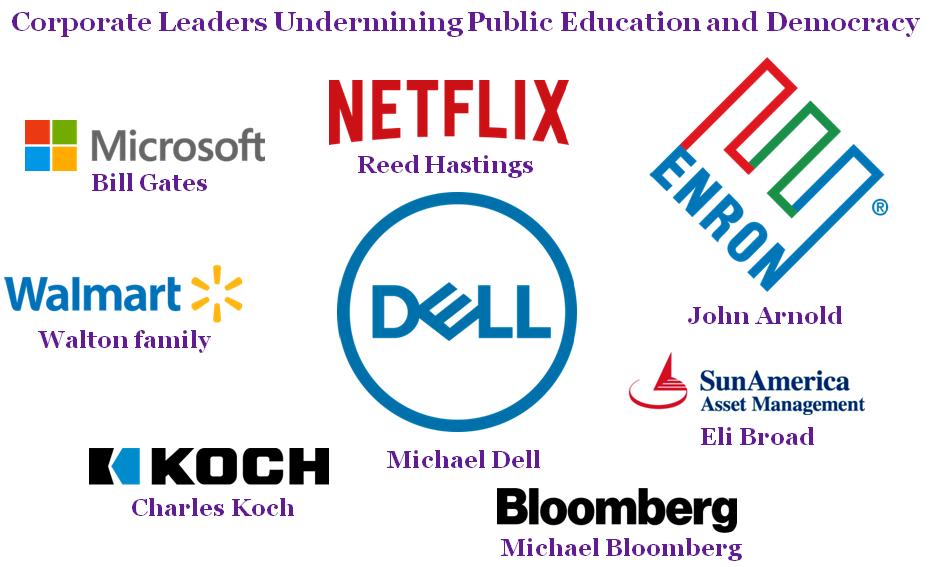By Thomas Ultican 2/17/2022
The agenda for privatizing public education embraces indoctrinating educators. Billionaire sponsors determined that overturning teacher and administrative training by public universities was essential. These “philanthropists” early on embraced Teach For America (TFA) and TNTP which expose teachers to a market centered way of thinking. In 2001, a new non-profit developed by graduate students at Harvard University focused on administrator training. The New Leaders for New Schools (NLNS) program taught a pro-privatization and business focused ideology to prospective school leaders.
Mercedes Schneider wrote in her book Chronicle of Echoes, “Wendy Kopp declared that she had a force of young, predominantly-Ivy League idealists for sale; Big Money arrived on the scene to make the purchase.” Wendy Kopp is the founder of TFA and the young idealists for sale were “temp teachers” who have no intention of staying in the classroom.
Why would they make this purchase? Microsoft’s Bill Gates nor The Gap’s Doris Fisher nor Sun America’s Eli Broad nor Walmart’s Alice Walton would have ever considered using untrained temps in key positions within their businesses. However, they have spent many hundreds of millions of dollars to push unqualified temp teachers into America’s classrooms.
In addition, an emerging plutocracy has routinely financed charter schools started by inexperienced TFA teachers and as the article “TNTP is a Part of the Destroy Public Education Infrastructure” observed, “Before the billionaire driven push to privatize public education, a “non-profit” company like TNTP would have gotten no consideration for training teachers because they were unqualified.”
The same story of financing unqualified or barely experienced people repeated itself in 2001 when a Harvard Graduate School inspired non-profit was launched. The NLNS team was woefully lacking in credentials or experience for training principals but they immediately attracted billionaire funding.
It becomes obvious that improving public schools is not the agenda. Rather, an injudicious belief that market based solutions were how to fix “failing” schools drove the benighted spending. The reality is that schools were not failing; some communities were. To sell their misguided policies and neoliberal ideology, five decades of “failing” schools hogwash has been produced by American tycoons along with five decades of “market-world” solutions. If the real agenda is ending universal free public education then maybe the spending is not benighted; just evil.

New Leaders for New Schools a Billionaire Financed Program
NLNS’s first usable presence on the Wayback Machine is a 2001 page. The history page says,
“In the spring of 2000, a team of five graduate students at Harvard Business School and the Harvard Graduate School of Education completed a business plan to launch New Leaders for New Schools. … The NLNS business plan was entered into the annual Harvard Business School business plan contest and NLNS became the first non-profit team ever to be selected as a semi-finalist in Harvard’s competition. … Soon after, New Leaders for New Schools received start-up funding from a number of venture philanthropists and venture capitalists.”
The 2001 web page also lists the founding team with short biographies.
CEO and Co-Founder: Jon Schnur was a policy advisor on K-12 education in the Clinton Administration. Jon was Associate Director for Educational Policy at the White House, Vice President Gore’s Senior Policy Advisor on education, and Special Assistant to the Secretary of Education. Jon led the Education Department’s team responsible for supporting the development of high-quality charter schools and addressing significant public policy issues related to the creation of these schools. He completed a Masters in Education at the Harvard Graduate School of Education.
President and Chief Curriculum Officer and Co-Founder: Monique M. Burns is currently completing her doctorate at the Harvard Graduate School of Education. She moved into education reform after business school, and opened four middle schools in Washington, DC through her work with the McKenzie Group. She was a Special Assistant to the Superintendent of the Philadelphia Public School District. While working on her doctorate, Monique has spent a year as a leadership coach and consultant for fourteen charter schools in Massachusetts. Monique’s dissertation is a study of the management and instructional leadership skills necessary for being a successful entrepreneurial leader of a start-up charter school.
Chief Operating Officer and Co-Founder: Benjamin G. Fenton is a graduate of Harvard Business School. He was a management consultant for McKinsey and Company. After leaving McKinsey, he worked for Fisher Scientific where he developed a marketing and sales strategy for their online procurement subsidiary, ProcureNet.
Director of Recruiting and Admissions and Co-Founder: Allison Gaines taught second grade in a New York City school. She has also worked as a journalist at Time Warner and as a producer for Brooklyn Academy of Music’s Education and Humanities Department, where she produced educational workshops with the Royal Shakespeare Company. Her experiences as a teacher drove her to focus on school reform through improved leadership. While working on a Masters Degree in Education at Harvard, specifically focused on School Leadership and Development, she co-wrote a handbook introducing the public to school reform initiatives and worked on parental involvement at the Boston Plan for Excellence.
While these people seem like someone a shrewd business man might want to hire. They did not have the experience and education background to compete with universities for training school leaders. The typical university program would have multiple doctorates in education and business with decades of experience. NLNS had two doctoral candidates focused on creating successful charter schools and a “reform” template. None of the founders had deep experience in schools.
Education policies from the Clinton administration provide some clues as to why they were financed. Marc Tucker, a leader in the standards-driven education reform movement, saw like-minded education reformers in the arriving Clinton administration who believed like him that the public school system was outdated and failing. His infamous November 11, 1992 “Hillary Letter” laid out several reform ideas that would completely change how education is done. He began:
“First, a vision of the kind of national — not federal — human resources development system the nation could have. … What is essential is that we create a seamless web of opportunities, to develop one’s skills that literally extends from cradle to grave and is the same system for everyone — young and old, poor and rich, worker and full-time student. It needs to be a system driven by client needs (not agency regulations or the needs of the organization providing the services), guided by clear standards that define the stages of the system for the people who progress through it, and regulated on the basis of outcomes that providers produce for their clients, not inputs into the system.”
The Clinton’s supported education standards, charter schools and TFA. Jon Schnur’s involvement in founding NLNS was proof that the new organization believed in the “failing” public schools mythology and neoliberal ideology. His co-founders were all either involved in the new business oriented education “reform” movement or came from a business centric organization like McKinsey and Company.
Almost as soon as NLNS legally established itself as a non-profit, the billionaire Eli Broad gifted them $1,056,000 (EIN: 95-4686318) and the New Schools Venture Fund kicked in another $253,000 (EIN: 94-3281780). By 2004, NLNS was claiming support from 10 foundations and corporations.

LittleSis Data Base Map: “New Leaders for Privatizing Schools”
The LittleSis Map above shows the large amounts gifted to NLNS by the biggest spenders on privatizing public education. If you go to the map and click on the entity names a large data base of spending and associations opens up. Today, NLNS lists over 90 corporate and foundation supporters. Those who have been following the people and corporations working to end public education will recognize many of the names listed.
NLNS’s Odd Naming History
Today, New Leaders for New Schools is more simply named New Leaders.
In 1995, The New Leaders (TNL) was formed to support talented Black community leaders and politicians. Its uniform source locator or url was “http://Newleaders.org.” In 2000, NLNS established an internet presence at url “http://www.nlns.org.”
In 2006, TNL announced that their legacy web page was being shutdown and would be re-launched. In 2007, the Newleaders.org page reappeared and in their about statement said, “New Leaders for New Schools is a national non-profit organization that selects and trains passionate and results-focused individuals, from within education, as well as former educators, to become urban public school principals.” There was no other explanation of the change in mission. The page also said, “For more information on our organization, please navigate to http://www.nlns.org.”
In 2011, the url “http://www.nlns.org” disappeared and New Leaders for New Schools changed name to New Leader with the url “http://Newleaders.org.”
Oakland, California and New Leaders
A 2005 press release from New Leaders announced their new partnership with Oakland Unified School District (OUSD) and updated their commitment with the Aspire charter school chain. Some of the following passages from the announcement make sense today.
“New Leaders also announced a major grant from the Bill & Melinda Gates Foundation which will support this work along with $200,000 from local funders, and $75,000 from the CA Charter Schools Association.”
“Representatives from New Leaders for New Schools were joined by Dr. Randolph Ward, OUSD State Administrator …”
“With the expansion of the New Leaders’ program in Oakland, up to 50 New Leaders principals will be recruited over the next 3 years, including up to 35 for OUSD and up to 15 for Bay Area charter schools.”
‘“We are excited to partner with New Leaders for New Schools to train outstanding educators to start urban charter high schools in the Bay Area,’ said Caprice Young, CEO of the California Charter Schools Association.”
This occurred less than two years after the state of California took control of OUSD. The state picked Randolph Ward to be the new Superintendent and gave him total control. He had just completed training at Eli Broad’s new superintendent’s training program and it is more than likely that the billionaire had a lot to do with Ward’s selection.
The Aspire charter school chain is run by the first charter management organization in America. It was established by Reed Hastings and Don Shalvey.
In new news, the OUSD’s school board just undid their October decision not to close schools. The reversal was a response to Alameda County Superintendent of Education L. Karen Monroe’s demand that they continued to close schools. She also ordered them to follow the dictates of the Fiscal Crisis Management Assist Team that has been involved with OUSD by order of the state since the 2003 takeover. Monroe’s order also carried an implied threat of another district takeover.
What made Monroe insist on closing public schools? Her county biography gives us a clue when it says, “L.K. holds a degree in Public Administration from the University of Southern California, a teaching credential from Holy Names University, and her administrative credential from the national New Leaders educational leadership program.” (Emphasis Added)
























